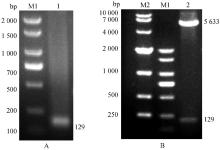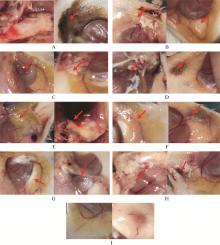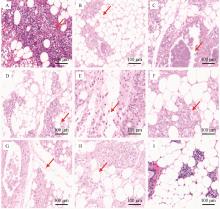





Acta Veterinaria et Zootechnica Sinica ›› 2025, Vol. 56 ›› Issue (6): 2836-2846.doi: 10.11843/j.issn.0366-6964.2025.06.027
• Preventive Veterinary Medicine • Previous Articles Next Articles
GUO Deyang1( ), HU Hui1(
), HU Hui1( ), ZHENG Xueli2,*(
), ZHENG Xueli2,*( ), JIANG Yanfen1,*(
), JIANG Yanfen1,*( )
)
Received:2024-05-27
Online:2025-06-23
Published:2025-06-25
Contact:
ZHENG Xueli, JIANG Yanfen
E-mail:1969415294@qq.com;huihu_66@163.com;zhengxueli@nwafu.edu.cn;jyf1111@nwafu.edu.cn
CLC Number:
GUO Deyang, HU Hui, ZHENG Xueli, JIANG Yanfen. Prokaryotic Expression and Analysis of Bacteriostatic Effects of Porcine β-defensin-1[J]. Acta Veterinaria et Zootechnica Sinica, 2025, 56(6): 2836-2846.

Fig. 1
PBD-1 PCR amplification and recombinant plasmid digestion A. The results of reverse transcription cDNA PCR amplification: M1. DNA 2 000 Marker; 1. Porcine spleen's cDNA. B. Positive plasmid double enzyme digestion electrophoresis results: M2. DNA 10 000 Marker; 2. Suspected positive plasmid of pET28a-SUMO-PBD-1"


Fig. 2
Purification condition screening, purification and digestion of recombination PBD-1 protein A. The selection of the optimal elution concentration; B. The purification of recombinant PBD-1; C. The digestion of recombinant PBD-1; M1. Protein marker; M2. Ultra-low molecular weight protein marker; 1. Supernatant after sonication; 2. Flow-through; 3-4, 11-12. Washing; 5-10. 25-250 mmol·L-1 imidazole elution; 13-19. 100 mmol·L-1 imidazole elution; 20. PBD-1-SUMO; 21. Digested for 18 h; 22. Digested for 22 h"

Table 1
Bacteria counts of mammary glands of mice mastitis model infected with E. coli 13-1 and S. aureus 4-1"
| 组别 Group | 攻毒量/(CFU/50 μL) Infection dosage | 细菌计数/(CFU·g-1) Bacteria count | |
| 大肠埃希菌 E.coli | 低剂量 Low-dose | 6.3×102 | 1.6×106 |
| 中剂量 Medium-dose | 6.3×103 | 8.0×108 | |
| 高剂量 High-dose | 6.3×104 | 1.6×109 | |
| 金黄色葡萄球菌 S. aureus | 低剂量 Low-dose | 1.4×103 | 4.7×105 |
| 中剂量 Medium-dose | 1.4×104 | 4.0×106 | |
| 高剂量 High-dose | 1.4×105 | 1.5×107 | |
| 生理盐水 Normal saline | / | <10 | |
| 空白对照 Blank control | / | <10 |

Fig. 7
Appearance of mammary glands of mice mastitis treated by recombinant PBD-1 A-D. Intramammary perfusion with normal saline, enrofloxacin, PBD-1 82 μg·mL-1 and PBD-1 164 μg·mL-1 after infected with S. aureus 4-1, respectively. E-H. Intramammary perfusion with normal saline, enrofloxacin, PBD-1 82 μg·mL-1 and PBD-1 164 μg·mL-1 after infected with E.coli 13-1, respectively. Ⅰ. Blank control"


Fig. 8
Histopathological appearance of mouse mammary gland (400×) A-D. Intramammary perfusion with normal saline, enrofloxacin, PBD-1 82 μg·mL-1 and PBD-1 164 μg·mL-1 after infected with S. aureus 4-1, respectively. E-H. Intramammary perfusion with normal saline, enrofloxacin, PBD-1 82 μg·mL-1 and PBD-1 164 μg·mL-1 after infected with E.coli 13-1, respectively. Ⅰ. Blank control"

| 1 |
SANTOS A S , LIMA D , ABAD A , et al. Antimicrobial resistance profile of non-aureus Staphylococci isolates from buffalo, goat and sheep mastitis in the Northeast region of Brazil[J]. J Dairy Res, 2020, 87 (3): 290- 294.
doi: 10.1017/S0022029920000771 |
| 2 |
WANG C , YANG Y , GAO N , et al. L-Threonine upregulates the expression of β-defensins by activating the NF-κB signaling pathway and suppressing SIRT1 expression in porcine intestinal epithelial cells[J]. Food Funct, 2021, 12 (13): 5821- 5836.
doi: 10.1039/D1FO00269D |
| 3 |
安清聪, 徐娜娜, 张春勇, 等. 不同水平乳铁蛋白对滇撒配套系仔猪生产性能、小肠形态学和机体抗病能力的影响[J]. 畜牧兽医学报, 2015, 46 (12): 2206- 2217.
doi: 10.11843/j.issn.0366-6964.2015.12.012 |
|
AN Q C , XU N N , ZHANG C Y , et al. The effect of different levels of lactoferrin on the growth performance, small intestinal morphology and body resistance to disease of diansa weaning piglets[J]. Acta Veterinaria et Zootechnica Sinica, 2015, 46 (12): 2206- 2217.
doi: 10.11843/j.issn.0366-6964.2015.12.012 |
|
| 4 |
朱芳, 李璐璐, 赵红奕, 等. 唾液乳杆菌对奶山羊隐性乳房炎的治疗效果分析[J]. 畜牧兽医学报, 2024, 55 (12): 5706- 5715.
doi: 10.11843/j.issn.0366-6964.2024.12.033 |
|
ZHU F , LI L L , ZHAO H Y , et al. Treatment effects of Lactobacillus salivarius on subclinical mastitis in dairy goats[J]. Acta Veterinaria et Zootechnica Sinica, 2024, 55 (12): 5706- 5715.
doi: 10.11843/j.issn.0366-6964.2024.12.033 |
|
| 5 |
孟璐, 胡海燕, 董蕾, 等. 基于SourceTracker分析牧场环境对乳房炎乳菌群的影响[J]. 畜牧兽医学报, 2023, 54 (9): 3872- 3883.
doi: 10.11843/j.issn.0366-6964.2023.09.026 |
|
MENG L , HU H Y , DONG L , et al. Influence of dairy farm environment on mastitis milk microbiota via sourcetracker[J]. Acta Veterinaria et Zootechnica Sinica, 2023, 54 (9): 3872- 3883.
doi: 10.11843/j.issn.0366-6964.2023.09.026 |
|
| 6 |
GABLI Z , DJERROU Z , GABLI A E , et al. Prevalence of mastitis in dairy goat farms in Eastern Algeria[J]. Vet World, 2019, 12 (10): 1563- 1572.
doi: 10.14202/vetworld.2019.1563-1572 |
| 7 | KUMAR N , BHAGWAT P , SINGH S , et al. A review on the diversity of antimicrobial peptides and genome mining strategies for their prediction[J]. Biochimie, 2024, 27, S0300- 9084(24)00157-3. |
| 8 |
KASEKE T B , CHIKWAMBI Z , GOMO C , et al. Antibacterial activity of medicinal plants on the management of mastitis in dairy cows: A systematic review[J]. Vet Med Sci, 2023, 9 (6): 2800- 2819.
doi: 10.1002/vms3.1268 |
| 9 |
TAN Z , DENG J , YE Q , et al. The antibacterial activity of natural-derived flavonoids[J]. Curr Top Med Chem, 2022, 22 (12): 1009- 1019.
doi: 10.2174/1568026622666220221110506 |
| 10 |
LIU H , WANG L , YAO C . Optimization of antibacterial activity and biosafety through ultrashort peptide/cyclodextrin inclusion complexes[J]. Int J Mol Sci, 2023, 24 (19): 14801.
doi: 10.3390/ijms241914801 |
| 11 | SANG Y , BLECHA F . Porcine host defense peptides: expanding repertoire and functions[J]. Dev Comp Immunol, 2009, 33 (3): 334- 343. |
| 12 | ELAHI S , BUCHANAN R M , ATTAH-POKU S , et al. The host defense peptide beta-defensin 1 confers protection against Bordetella pertussis in newborn piglets[J]. Infect Immun, 2006, 74 (4): 2338- 2352. |
| 13 | WAN M L , LING K H , WANG M F , et al. Green tea polyphenol epigallocatechin-3-gallate improves epithelial barrier function by inducing the production of antimicrobial peptide pBD-1 and pBD-2 in monolayers of porcine intestinal epithelial IPEC-J2 cells[J]. Mol Nutr Food Res, 2016, 60 (5): 1048- 1058. |
| 14 | SHEIBANI N . Prokaryotic gene fusion expression systems and their use in structural and functional studies of proteins[J]. Prep Biochem Biotechnol, 1999, 29 (1): 77- 90. |
| 15 |
郭海勇, 袁洪兴, 王云霄, 等. 重组猪β-防御素1对大肠杆菌的抑制作用[J]. 畜牧兽医学报, 2017, 48 (7): 1342- 1348.
doi: 10.11843/j.issn.0366-6964.2017.07.019 |
|
GUO H Y , YUAN H X , WANG Y X , et al. Inhibitory effects of recombinant porcine beta-defensin 1 on Escherichia coli[J]. Acta Veterinaria et Zootechnica Sinica, 2017, 48 (7): 1342- 1348.
doi: 10.11843/j.issn.0366-6964.2017.07.019 |
|
| 16 | HUANG H J , GAO Q S , QIAN Y G , et al. Recombinant PBD-1 (porcine beta-defensin 1) expressed in the milk by transplanting transgenic mES-like-derived cells into mouse mammary gland[J]. Cell Biol Int, 2010, 34 (10): 1033- 1040. |
| 17 | 全锁配. 猪β-防御素-1的原核表达及其微胶囊的制备[D]. 合肥: 安徽农业大学, 2020. |
| QUAN S P. Prokaryotic expression and preparation of microcapsules of porcine β-defensin-1[D]. Hefei: Anhui Agricultural University, 2020. (in Chinese) | |
| 18 | 朱慧君. 猪β防御素-1与溶菌酶在黑曲霉中的表达和抗菌活性分析[D]. 哈尔滨: 东北农业大学, 2023. |
| ZHU H J. Expression and antibacterial activity analysis of Porcine β-defensin-1 and lysozyme in Aspergillus niger[D]. Harbin: Northeast Agricultural University, 2023. (in Chinese) | |
| 19 | JANG J, HUR H G, SADOWSKY M J, et al. Environmental Escherichia coli: ecology and public health implications-a review. J Appl Microbiol, 2017, 123(3): 570-581. |
| 20 | ZHENG X , YANG N , MAO R , et al. Pharmacokinetics and pharmacodynamics of antibacterial peptide NZX in Staphylococcus aureus mastitis mouse model[J]. Appl Microbiol Biotechnol, 2024, 108 (1): 260. |
| 21 | TAO Q , LU Y , LIU Q , et al. Antibacterial activity of the antimicrobial peptide PMAP-36 in combination with tetracycline against porcine extraintestinal pathogenic Escherichia coli in vitro and in vivo[J]. Vet Res, 2024, 55 (1): 35. |
| 22 | ZHU Y , HAO W , WANG X , et al. Antimicrobial peptides, conventional antibiotics, and their synergistic utility for the treatment of drug-resistant infections[J]. Med Res Rev, 2022, 42 (4): 1377- 1422. |
| 23 | 赵晶晶, 李晓凤, 刘保国, 等. 两种方法测试抗菌肽与抗生素的联合抑菌效果[J]. 现代农业科技, 2024, 4, 139-142, 155. |
| ZHAO J J , LI X F , LIU B G , et al. Two methods for testing combined antibacterial effects of antimicrobial peptide and antibiotics[J]. Modern Agricultural Science and Technology, 2024, 4, 139-142, 155. |
| [1] | ZHAO Yunhai, ZHANG Yangyang, MA Haiyun, WANG Qing, HE Xiaoxiao, LIU Kai, ZHANG Yuting, LIU Yudong, YANG Yongning, WU Xiaochun, XING Xiaoyong, QUAN Guomei, ZHANG Zhixiong, BAO Shijun. Prokaryotic Expression and Adhesion Characteristics of Molecular Chaperone Dnak of Mycoplasma bovis [J]. Acta Veterinaria et Zootechnica Sinica, 2025, 56(6): 2868-2878. |
| [2] | QIAO Yarui, MIAO Yuhang, HUANG Qian, ZHOU Xuezhang. Research on the Biological Characteristics of Enterococcus faecalis in Dairy Cow Mastitis in Ningxia [J]. Acta Veterinaria et Zootechnica Sinica, 2025, 56(5): 2325-2339. |
| [3] | WU Qiong, LI Lingdan, YUAN Hui, BIN Chen, DENG Ke, LI Wei, YE Shiyi, LI Guopan, SHEN Qingchun, XIONG Tao. Prokaryotic Expression of PoIFN-α 8s and Identification of Its Activity in vitro and in vivo [J]. Acta Veterinaria et Zootechnica Sinica, 2025, 56(5): 2413-2423. |
| [4] | FAN Manting, HUANG Ruoting, SHE Yuanhang, GUO Jianchao, LIU Jianying, GUO Yongqing. Research Progress on the Application of Omics Technology in the Pathogenesis and Diagnosis of Mastitis in Dairy Cows [J]. Acta Veterinaria et Zootechnica Sinica, 2025, 56(3): 1076-1088. |
| [5] | SHAO Yongheng, NI Minting, GAO Mengling, TANG Jiao, ZHANG Gengxin, LIN Shengyu, LIU Guangliang, CHEN Jianing, WANG Wenhui. Prokaryotic Expression of VP1 Protein to Porcine Teschovirus Type 5 and the Establishment of an Indirect ELISA Detection Method [J]. Acta Veterinaria et Zootechnica Sinica, 2025, 56(2): 883-889. |
| [6] | ZENG Miaomiao, YANG Xiaoman, ZHANG Xin, LIU Dakai, SHI Hongyan, ZHANG Jiyu, ZHANG Liaoyuan, CHEN Jianfei, FENG Tingshuai, LI Xiuwen, SHI Da, FENG Li. Establishment and Preliminary Application of an Indirect ELISA for Swine Acute Diarrhea Syndrome Coronavirus N Protein [J]. Acta Veterinaria et Zootechnica Sinica, 2025, 56(1): 319-326. |
| [7] | WANG Haolei, LIU Mengyan, LONG Quan, LI Manman, LÜ Xiang, LIN Tao, JIANG Caode. Inhibition of Epicatechin Gallate on Inflammation and Pyroptosis as Well as NF-κB Pathway and NLRP3 Inflammasome in MAC-T Cells and Mouse Mammary Glands [J]. Acta Veterinaria et Zootechnica Sinica, 2025, 56(1): 430-441. |
| [8] | Liguo GAO, Hanqin SHEN, Yiquan CHEN, Sheng CHEN, Wencheng LIN, Feng CHEN. Prokaryotic Expression of Recombinant VP6* Protein of Porcine Rotavirus and Establishment of Indirect ELISA Detection Method [J]. Acta Veterinaria et Zootechnica Sinica, 2024, 55(9): 4021-4028. |
| [9] | Yanxin CHEN, Ruiqi HUA, Guoqing SHAO, Xiaowei ZHU, Wei HOU, Shengqiong LI, Aiguo YANG, Guangyou YANG. Prokaryotic Expression and Secretion Characterization of Annexin B5, B15, and B25 from Echinococcus granulosus [J]. Acta Veterinaria et Zootechnica Sinica, 2024, 55(6): 2607-2618. |
| [10] | SONG Xiaoqing, DENG Ruide, LI Xin, LI Jiao, LI Runcheng, DU Lifei, DONG Wei, GE Meng. Establishment of ELISA for Detection of PCV4-Cap Antibody and Sero-epidemiological Survey [J]. Acta Veterinaria et Zootechnica Sinica, 2024, 55(5): 2072-2079. |
| [11] | LUO Xiaofen, XIE Xiaodong, ZHAO Chao, HU Qian, WANG Yongxuan, RAN Fangfei, HU Pengfei, WEN Ming, ZHU Erpeng, CHENG Zhentao. Initial Identification of Adhesion-related Proteins of Mycoplasma bovis of Guizhou Strains [J]. Acta Veterinaria et Zootechnica Sinica, 2024, 55(4): 1672-1683. |
| [12] | LU Jinye, GAO Yabing, HAN Xinru, LIU Yuzhen, ZHAO Jiayu. The Effect of Streptococcus uberis Infection on Amino Acid Metabolism in Mammary Epithelial Cells [J]. Acta Veterinaria et Zootechnica Sinica, 2024, 55(4): 1766-1776. |
| [13] | LUO Chenghui, GAO Jiangrui, CHEN Junwei, WEI Chunjie, WEI Shuangshuang, PEI Yechun. Construction of Mouse Model of Dust Mite Induced Atopic Dermatitis and Asthma [J]. Acta Veterinaria et Zootechnica Sinica, 2024, 55(3): 1257-1267. |
| [14] | WU Wenying, XIA Qing, HU Mengjie, ZHAO Yixuan, WANG Chen, ZHANG Yuhao, HAO Chengwu, HE Sun, GUO Aizhen, CHEN Jianguo, CHEN Yingyu. Establishment of Rabbit Challenge Model of Mycoplasma bovis [J]. Acta Veterinaria et Zootechnica Sinica, 2024, 55(3): 1268-1277. |
| [15] | ZHUANG Cuicui, HAN Bo. Mechanism of Mitochondrial Damage in Bovine Mammary Epithelial Cells and Mouse Mammary Gland Infected with Escherichia coli Isolated from Bovine Mastitis [J]. Acta Veterinaria et Zootechnica Sinica, 2024, 55(2): 822-833. |
| Viewed | ||||||
|
Full text |
|
|||||
|
Abstract |
|
|||||